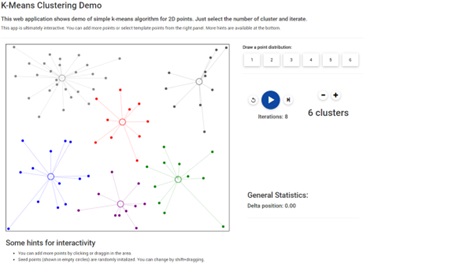Refining Color Scheme Generation: Iterative K-Means Clustering and ARI Evaluation

DOI:
https://doi.org/10.54060/a2zjournals.jieee.112Keywords:
Within-Cluster Sum of Squares (WCSS), Adjusted Rand Index (ARI), Color Scheme Generation, image-based color scheme generation, K-means clusteringAbstract
Color goes beyond mere visual sensation, holding profound sway over emotions, thoughts, and perceptions. It communicates, evokes moods, and significantly influences judgments. Research underscores its importance, with up to 90% of product assessments being based solely on color, highlighting its pivotal role in crafting memorable experiences and defining brand identities. The fusion of art and technology presents a captivating synergy within the realm of image-derived color schemes. Color palette generation from images is pivotal in graphic design, interior decoration, and digital media. This study delves into methodologies for extracting dominant colors from images and generating cohesive color schemes. Leveraging K-Means clustering with the Within-Cluster Sum of Squares (WCSS) method, we showcase superior performance compared to traditional approaches. The evaluation of palette coherence using the Adjusted Rand Index (ARI) facilitates consistency within the generated color schemes. Integrating methodologies with design tools and advanced color harmonies opens avenues for further innovation and customization. This study underscores the transformative potential of image-based color scheme generation, bridging the gap between computational analysis and creative expression. Through the convergence of artistry and technological prowess, we aim to enhance the design landscape and enrich user experiences across various applications and industries.
Downloads
References
“Theory of colour Harmony and its application,” Tehnicki Vjesnik, vol. 25, no. 4, 2018.
P. Weingerl, A. Hladnik, and D. Javoršek, “Development of a machine learning model for extracting image prominent col-ors,” Color Res. Appl., vol. 45, no. 3, pp. 409–426, 2020.
E. Kim, J. Lee, and S. Park, “Image-Based Color Palette Extraction for Interior Design Using Probabilistic Clustering,” IEEE Transactions on Industrial Informatics, vol. 19, pp. 1184–1195, 2021.
Q. Zheng, M. Lu, S. Wu, R. Hu, J. Lanir, and H. Huang, “Image-guided color mapping for categorical data visualization,” Comput. Vis. Media (Beijing), vol. 8, no. 4, pp. 613–629, 2022.
N. Dhanachandra and Y. J. Chanu, “A survey on image segmentation methods using clustering techniques,” Eur. J. Eng. Res. Sci., vol. 2, no. 1, p. 15, 2017.
K. Li, J. Li, Y. Sun, C. Li, and C. Wang, “Color assignment optimization for categorical data visualization with adjacent blocks,” J. Vis. (Tokyo), vol. 26, no. 4, pp. 917–936, 2023.
S. Tongbram, B. A. Shimray, and L. S. Singh, “Segmentation of image based on k-means and modified subtractive cluster-ing,” Indones. J. Electr. Eng. Comput. Sci., vol. 22, no. 3, p. 1396, 2021.
H. M. A. Hossain, S. M. S. Zabir, M. R. Rahman, and M. S. Uddin., Eds., A Hybrid Algorithm for K-means Clustering with Improved WCSS Criteria. 2018.
R. A. M. Benlahrech, A. Oulad Sidi Abdellaoui, and M. El Ayadi., Eds., A Comparative Study of Clustering Techniques: K-means vs. Improved K-means Using WCSS Criteria. 2020.
M. J. Warrens and H. van der Hoef, “Understanding the adjusted Rand index and other partition comparison indices based on counting object pairs,” J. Classif., vol. 39, no. 3, pp. 487–509, 2022.
W.-X. Kang, Q.-Q. Yang, and R.-P. Liang, “The comparative research on image segmentation algorithms,” in 2009 First In-ternational Workshop on Education Technology and Computer Science, 2009.
H. Cui, N. Giebink, J. Starr, D. Longert, B. Ford, and É. Léveillé-Bourret, “From noisy data to useful color palettes: One step in making biodiversity data FAIR,” in Lecture Notes in Computer Science, Cham: Springer Nature Switzerland, 2023, pp. 469–481.
I. G. M. Karma, I. K. G. Darma Putra, M. Sudarma, and L. Linawati, “Image segmentation based on color dissimilarity,” In-formatica (Ljubl.), vol. 46, no. 5, 2022.
S. Kim, J. Suh, and K. H. Lee, “A Review of Color Harmony Generation Techniques for Digital Media,” Computers in Indus-try, vol. 129, 2021.
A. Forsythe, “Color and Emotion: Effects of Hue, Saturation, and Brightness,” Psychological Studies, vol. 63, no. 4, pp. 385–395, 2018.
X. Wang, Y. Wu, and Y. Liu, “Unsupervised Learning-based Color Scheme Generation for UI Design,” in IEEE 6th Interna-tional Conference on Cloud Computing and Intelligence Systems (CCIS), 2019.
L. Zhang, M. Sun, X. Chen, and X. Gao, “Improved Color Palette Generation Method Based on K-means Algorithm,” in 6th International Conference on Advanced Robotics and Mechatronics (ICARM), 2023.
J. Liu, D. Zeng, W. Li, and H. Huang, “Image-based color scheme generation using unsupervised learning,” Journal of Visual Communication and Image Representation, vol. 81, 2021.
Li, Z. Cheng, Y. Zhu, and W. Wang, “A color palette generation method based on K-means clustering algorithm,” in 2020 IEEE International Conference on Artificial Intelligence and Computer Applications (ICAICA), 2020.
Q. Wu, L. Zhang, X. Liu, and Y. Liu, “Unsupervised Learning-based Color Palette Generation for Digital Art,” in 2nd Interna-tional Conference on Intelligent Autonomous Systems (ICIAS), 2019.
Y. Ma, H. Hu, and J. Zhu, “An Improved Color Scheme Generation Algorithm Based on Unsupervised Learning,” in 2021 International Conference on Machine Learning and Intelligent Systems (MLIS), 2021.
J. Kim and S. Lee, “Color Palette Generation using Unsupervised Learning for Digital Art,” in 2022 IEEE International Con-ference on Image Processing (ICIP), 2022.
Y. Guo, Y. Wang, and H. Liu, “Improved K-means Clustering Algorithm Based on WCSS Weight Coefficients,” in 2021 Inter-national Conference on Electronics, 2021.
Z. Li, X. Chen, and S. Jiang, “A Novel Clustering Algorithm Based on Weighted WCSS,” in 2022 International Conference on Intelligent Information Processing (ICIIP), 2022.
Y. Wang, L. Zhang, and J. Wang, “Research on Optimization of K-means Algorithm Based on WCSS,” in 2020 International Conference on Control, Automation and Diagnosis (ICCAD), 2020.
J. Yang, H. Zhang, and H. Xie, “A New K-means Clustering Algorithm Based on WCSS Weighting and Local Search,” in 4th International Conference on Artificial Intelligence and Big Data (ICAIBD), 2019.
Y. Zhang, Q. Li, and X. Wang, “Improved K-means Clustering Algorithm Based on Adaptive WCSS Calculation,” in 2023 In-ternational Conference on Intelligent Information Processing (ICIIP), 2023.
Z. Liu, H. Zhang, and J. Wu, “Optimization of K-means Clustering Algorithm Based on Euclidean Distance and WCSS,” in 2022 International Conference on Big Data and Artificial Intelligence (ICBDAI), 2022.
Y. Sun, L. Liu, and H. Zhang, “An Improved K-means Algorithm Based on Density and WCSS,” in 2019 International Con-ference on Big Data, Cloud Computing, and Data Science Engineering (ICBCD), 2019.
J. Chen, Y. Wang, and Q. Liu, “An Improved K-means Algorithm Based on Dynamic WCSS Calculation,” in 2021 Internation-al Conference on Advanced Information Technology, Electronic and Automation Control Conference (IAEAC), 2021.

Downloads
Published
How to Cite
CITATION COUNT
Issue
Section
License
Copyright (c) 2020 Abhinandan Yadav, Dr. P. Singh

This work is licensed under a Creative Commons Attribution 4.0 International License.

























